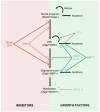Targeting oligodendrocyte protection and remyelination in multiple sclerosis
- PMID: 21425268
- PMCID: PMC3074606
- DOI: 10.1002/msj.20244
Targeting oligodendrocyte protection and remyelination in multiple sclerosis
Abstract
Multiple sclerosis is an inflammatory demyelinating disease of the brain and spinal cord with a presumed autoimmune etiology. Conduction block in demyelinated axons underlies early neurological symptoms, whereas axonal transection is believed responsible for more permanent later deficits. Approved treatments for the disease are immunoregulatory and reduce the rate of lesion formation and clinical exacerbation, but are only partially effective in preventing the onset of disability in multiple sclerosis patients. Approaches that directly protect myelin-producing oligodendrocytes and enhance remyelination may improve long-term outcomes and reduce the rate of axonal transection. Studies in genetically modified animals have improved our understanding of mechanisms underlying central nervous system pathology in multiple sclerosis models, and have identified pathways that regulate oligodendrocyte viability and myelin repair. However, although clinical trials are ongoing, many have been unsuccessful, and no treatments are yet approved that target these areas in multiple sclerosis. In this review, we examine avenues for oligodendrocyte protection and endogenous myelin repair in animal models of demyelination and remyelination, and their relevance as therapeutics in human patients.
© 2011 Mount Sinai School of Medicine.
Figures

References
-
- McDonald WI, Sears TA. Effect of demyelination on conduction in the central nervous system. Nature. 1969;221(5176):182–3. - PubMed
-
- Trapp BD, et al. Axonal transection in the lesions of multiple sclerosis. N Engl J Med. 1998;338(5):278–85. - PubMed
-
- Smith EJ, Blakemore WF, McDonald WI. Central remyelination restores secure conduction. Nature. 1979;280(5721):395–6. - PubMed
-
- Prineas JW, Connell F. Remyelination in multiple sclerosis. Ann Neurol. 1979;5(1):22–31. - PubMed
-
- Chang A, et al. Premyelinating oligodendrocytes in chronic lesions of multiple sclerosis. N Engl J Med. 2002;346(3):165–73. - PubMed
Publication types
MeSH terms
Substances
Grants and funding
LinkOut - more resources
Full Text Sources
Medical

